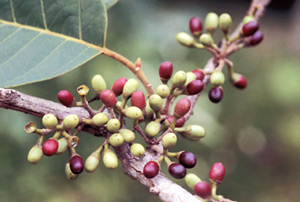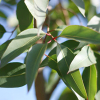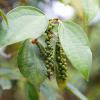Everything you need to know about May Chang Essential Oil
 For many years May Chang essential oil was listed by most aromatherapy suppliers under its botanical name of Litsea cubeba, but more recently the more enchanting name of may chang seems to have been adopted by our industry.
For many years May Chang essential oil was listed by most aromatherapy suppliers under its botanical name of Litsea cubeba, but more recently the more enchanting name of may chang seems to have been adopted by our industry.
It is also occasionally referred to as Exotic Verbena or Tropical Verbena, although despite the references to verbena, the plant is not related in any way to true verbena (Lippia citriodora). The association to this name would appear to be due to the similarity in fragrance.
In fact, it is not uncommon for may chang essential oil to be passed-off as ‘verbena’ to an unsuspecting or inexperienced buyer. In the perfumery industry, it is used as a starting material for the extraction of natural citral, and it is even known to be used to adulterate true Melissa oil, although such clumsy adulteration is quite easy to spot by an expert.
Physical description
The species Litsea cubeba belongs to the Lauraceae family and is also known as Chinese Pepper and Mountain Pepper. It is a small deciduous tree that grows to a height of 5 to 8 metres (16-26 feet), with a smooth trunk measuring 6-20 centimetres (2.5 to 8 inches) in diameter. The tree bears white or pale yellow, lemon-scented flowers, and small fruits which are similar in shape to small peppers, from which the word ‘cubeb’ is derived.
Measuring between 4 to 6 millimetres in diameter, the aromatic fruits are almost spherical in shape and green in colour, turning red then dark brown upon ripening. When dried, these small fruits look like large, dried black peppers and provide the source of may chang essential oil, although oil can also be extracted from the flowers, branches, bark, roots and leaves too. The pure essential oil derived from these parts of the plant does not have the same odour as the fruits though.
The white or pale yellow flowers that grow in clusters on the tree are also lemon-scented and were at one time used to flavour tea in China.
Geographical sources
Litsea cubeba is native to China, Indonesia and other areas of Southeast Asia. In China, it grows naturally in the south and has been cultivated in central and eastern areas to the south of the Yangtze river for its various commercial uses. Smaller quantities of this species also grow wild in Java, Sumatra and Kalimantan, between a height of 700 metres and 2,300 meters above sea level. It is also cultivated in Japan and Taiwan.
May chang essential oil did not become available in the Western world until the early 1950’s when it began to compete with lemongrass as source material for the extraction of citral. Widely used in soaps, fragrances and flavourings, production of the essential oil is still almost entirely based in China, and very little is currently known about their methods of cultivation or harvesting.
Traditional uses
The plant has a long history of use in Chinese herbal medicine, and all parts of the plant were used to provide remedies for asthma, back pain, chills, digestive problems, dysmenorrhoea, headaches and muscular aches and pains. It was believed to have carcinostatic properties and therefore employed to treat cancer.
Recent research in China investigated the ability of may chang essential oil to regulate cardiac arrhythmia when compared to the beta-blocker, Propranolol. The results were encouraging and showed that it reduced artificially induced arrhythmia from 15 minutes to 6.5 minutes, compared to the drugs performance 15 mins to 0.6 mins. Impressive, for a natural remedy.
Fragrant memories
May chang oil is extracted by steam distillation of the fresh fruits, and yields a pale yellow liquid with a fresh, intensely lemon fragrance with fruity and spicy undertones. For many people, the aroma brings back happy memories of sherbet-lemon sweets! Its lemony fragrance is similar to but much sweeter and more refined than lemongrass, which has grassy, fishy and fatty banknotes. Due to this lemon sweetness, essential oil of may chang is used extensively in the perfumery, cosmetic and flavour industries.
Benefits of may chang essential oil
May chang essential oil has refreshing, stimulating and uplifting action, which makes it perfect for relieving fatigue and lethargic psychological states. So when you are suffering from a severe case of the blues, add a few drops of this oil to your diffuser for a quick pick-me-up. And because this oil is a tonic to the nervous system it makes it ideal for clearing your head when you are feeling anxious, stressed or befuddled.
It has surprisingly good antiseptic, antifungal and antiviral properties too, which can be used to help keep coughs, colds and athletes foot at bay. It’s also great for cleaning jobs around the home such as sterilizing kitchen worktops. To boost its effectiveness, the blend may chang with tea tree and you’ll have a powerful cleansing action without the unpleasant disinfectant-like aroma. When vaporised, it also acts as a respiratory tonic.
Use it in skincare for its mild astringent properties which can be helpful with acne and oily skin. May chang oil is also a very effective deodorant that helps to reduce excess perspiration, so added to a lotion it can be used to make an all-over body lotion. This oil may be mildly sensitising to a few individuals, but since it has a powerful aroma you only need tiny amounts which reduce the likelihood of it being a problem for most people.
May chang essential oil blends well with a wide range of other essential oils, introducing a lovely fresh lemon-citrus note wherever you use it. Try it with basil, bergamot, clary sage, geranium, ginger, jasmine, lavender, linaloe wood, petitgrain, rose, rosemary, ylang ylang and all citrus oils.
See Quinessence May Chang Essential Oil
Copyright © Quinessence Aromatherapy Ltd 2014.































